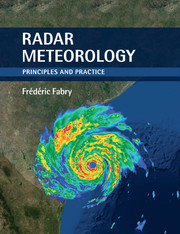Book contents
- Frontmatter
- Dedication
- Contents
- Preface
- Notation
- 1 Meteorology and radar
- 2 Fundamentals of weather radar measurements
- 3 Radar reflectivity and products
- 4 Reflectivity patterns
- 5 Doppler velocity information
- 6 The added value of dual polarization
- 7 Convective storm surveillance
- 8 Monitoring widespread systems
- 9 Radar estimation of precipitation
- 10 Nowcasting
- 11 Additional radar measurements and retrievals
- 12 Cloud and spaceborne radars
- 13 What does radar really measure?
- Appendix A Mathematics and statistics of radar meteorology
- References
- Index
7 - Convective storm surveillance
Published online by Cambridge University Press: 05 June 2015
- Frontmatter
- Dedication
- Contents
- Preface
- Notation
- 1 Meteorology and radar
- 2 Fundamentals of weather radar measurements
- 3 Radar reflectivity and products
- 4 Reflectivity patterns
- 5 Doppler velocity information
- 6 The added value of dual polarization
- 7 Convective storm surveillance
- 8 Monitoring widespread systems
- 9 Radar estimation of precipitation
- 10 Nowcasting
- 11 Additional radar measurements and retrievals
- 12 Cloud and spaceborne radars
- 13 What does radar really measure?
- Appendix A Mathematics and statistics of radar meteorology
- References
- Index
Summary
A forecast approach
By its nature, convection is a relatively fast process. Most thunderstorm cells last less than an hour. Powerful updrafts and downdrafts are generated, resulting in locally heavy precipitation and strong winds. Several tens of cells can be present at once within the coverage of a single radar. They are organized in a variety of patterns and interact rapidly and in complex ways with their neighbors (supplement e07.1). This occurs as a result of the generally poorly observed interactions between storm flows.
Due to its short temporal and small spatial scale, convective weather is difficult to monitor without the help of remote sensing. Once it was realized that radar could provide data within storms almost instantaneously, it quickly became the instrument of choice for the surveillance of convective weather. This ability is the main reason why radar networks have been installed in many countries.
Upon reflection though, radar detects storms properly only very late in their formation process: it does not detect the destabilization of the atmosphere; rarely will it observe a storm's triggering mechanism, except at close range in the case of colliding out flows; it cannot detect the initial updraft, and except at extremely close range, it does not observe the burgeoning cloud. Only when the resulting precipitation starts to form do we have a first clue that something is happening, and only when a storm is mature can we make a full assessment of the situation.
To add to the difficulty of the weather surveillance and forecasting task, radar provides a large amount of data. Every hour, hundreds of PPIs of sometimes hard-to-interpret fields such as Doppler velocity or reflectivity from many types of targets are collected. Sifting through such data is a lengthy process. Yet, the fast evolution of convective storms implies that the threat detection must be done rapidly. Even with the help of automatic severe weather detection procedures such as the mesocyclone detection or the weak echo region (WER) identification algorithms, the correct interpretation of radar data takes time and must therefore be achieved as efficiently as possible.
- Type
- Chapter
- Information
- Radar MeteorologyPrinciples and Practice, pp. 115 - 132Publisher: Cambridge University PressPrint publication year: 2015



